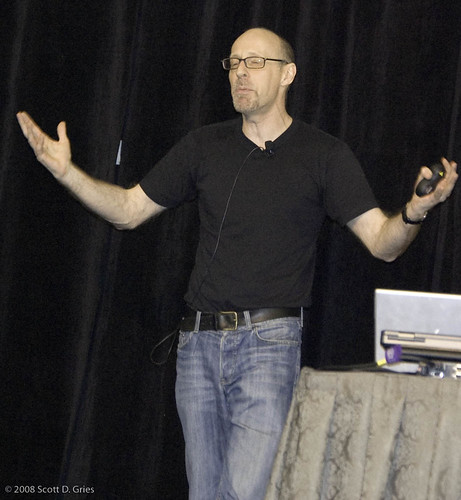The final day of TAM began with the normal continental breakfast. Since there was no early event today, I actually sat in that room and enjoyed my food, along with some friendly, talkative companions. This morning closed the conference, consisting of 20-minute paper presentations by a variety of individuals with very mixed results.
First up was John S. Janks, a retired remote sensing scientist from Texaco/Chevron. His talk attempted to demonstrate that "hard scientific data can successfully explain...the Marfa Lights of West Texas." It was, arguably, the least interesting talk of the entire conference.
Don G. Nyberg, Professor of Analytical Chemistry (SUNY), took the stage next to discuss "What Every Student Needs to Hear from Every Science Teacher." His fairly hardcore viewpoint says that students with preconceived pseudoscientific beliefs need to be confronted with evidence-based science and the methodology of critical thinking and scientific inquiry. The talk was pretty interesting (if somewhat on the extreme side), but Professor Nyberg was not well-prepared for this audience - he prepared what looked like a 60-minute talk (for a 20-minute slot) and expected only about 15 people (instead of the 300 or so in attendance).
At 9:20(ish), Steve Cuno, the chairman of RESPONSE Prospecting & Loyalty Strategies, talked about "Niche Pseudoscience" and the need to fight pseudoscience in very specific niches, such as his own field of marketing (many examples given). It was an interesting talk, although Mr. Cuno had an odd speaking style.
Next up was Tracy King, Managing Director for February Marketing, assistant to Richard Wiseman, Miss February in the 2008 Skepchick Calendar and TEEK on the JREF Forum. She discussed what she called "The Most Famous Science Video in the World" (the Colour Changing Card Trick) and "How to Make your Message Famous." In addition to various marketing techniques for creating successful marketing campaigns she also discussed other viral videos such as the Evolution of Dance (love that one), Filipino prisoners, Star Wars Kid and the Gorilla Drum commercial. Informative and entertaining, as I would expect from an associate of Wiseman.
After a short break, Lee Graham, a PhD student at Carleton University (Ottawa, Canada) took us on a tour of his zoo of 3D virtual creatures in a talk about "Artificial Creatures, Real Evolution" where he discussed his project to use evolution rules to evolve computer-generated creatures. It was a fascinating discussion. My favorite creature shown had to be the end-over-end worm, shown below. More of his work can be seen on his project site. We can even play in his zoo, although his program only operates on Windows and I'm nearly purely Mac-based now.
Following the 3DVCE presentation was a discussion on the "Psychology of Anomalous Experiences," by Christopher C. French from the Department of Psychology, Goldsmiths College in London and editor of Skeptics Magazine, U.K. Although somehow he managed to have the wrong version of his presentation on hand, the talk on the "study of extraordinary phenomena of behavior and experience, in an attempt to provide non-paranormal explanations in terms of known psychological and physical factors" went well nonetheless. Interesting, although Sue is more the psychological type than I am.
Tim Farley, creator of "What's The Harm," discussed "Building Internet Tools for Skeptics" to help disseminate the information needed to encourage critical thinking. The site seems pretty interesting and I plan to delve more deeply into it.
Finally, Brian Dunning, host of Skeptoid, took the last spot, showing us the making of "The Skeptologists." At some point during the conference (possibly today), we actually got the watch the entirety of the pilot episode. I think the cast they have chosen is potentially a good one (with an excellent scientific/skeptical background), but the scripting and other technical work could stand to be handled by those with more experience. I do hope the show gets picked up by a network so it gets the chance!
All in all, TAM6 was a fascinating experience. It would have been a bit better if I had gone to it with a friend or two (people who knew me, as opposed to the couple dozen people I knew who have no idea who I am) - I am not gregarious enough to spontaneously generate new friends wherever I go, although I did meet a few folks.
The rest of the day was spent largely in the main bar chatting with various TAM attendees (none of whom seem to have gone home after the convention!).
TAM7 will be held at the new Southpoint Casino in Las Vegas (off the Strip) from July 9th through 12th in 2009. We'll see if I brave a second trip out to Vegas for it!
Image Remix on the AI Horde
-
The initial deployment of the Stable Cascade (SC) on the AI Horde supported
just text2image workflows, but that was just a subset of what this model
can do...






